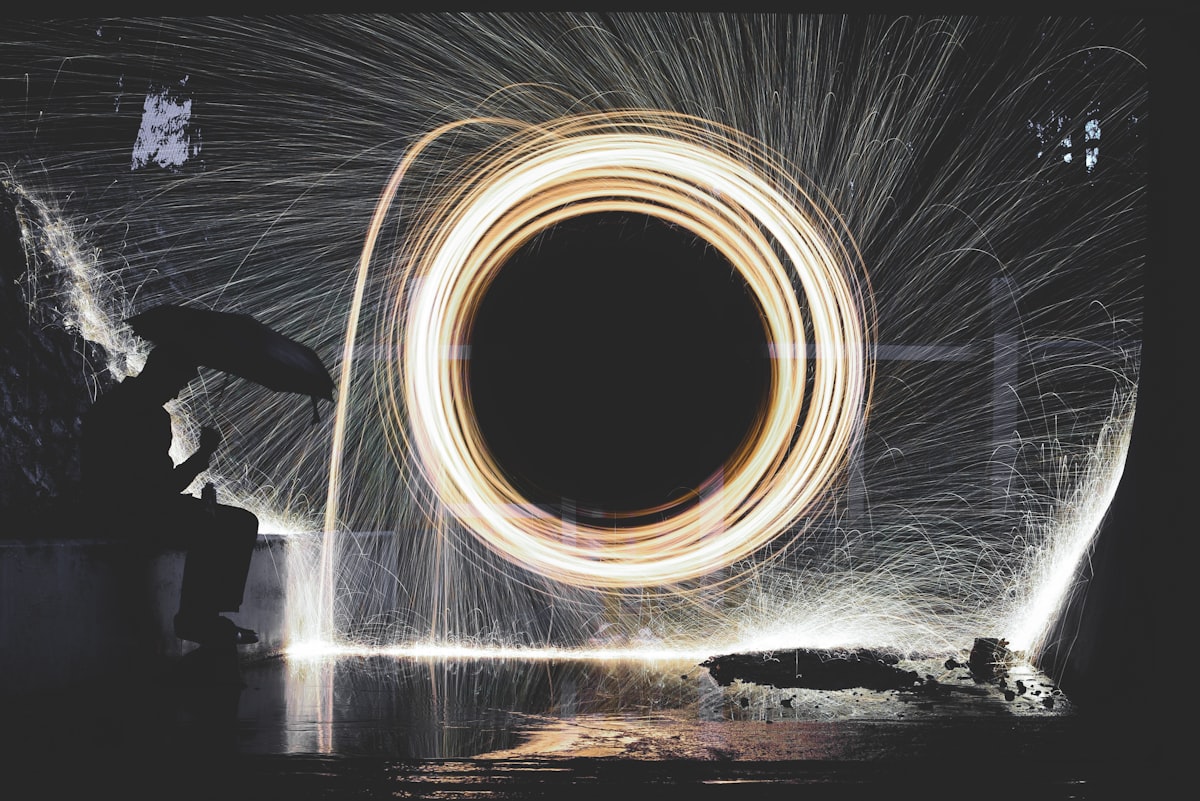Living around a rogue black hole
Interstellar menace or life-giving gardens for space travelers?

It's lonely, dark, and mighty big out there in deep space
There's a lot of stuff out there that we just don't understand. Once you're away from the comfy street-lamps of the stars, there could be just about anything lurking in those dark alleys.
Those aching depths of alienation in time and space were one inspiration for the "rogue planet" name. Planets kicked out of their home solar systems, cursed to wander the infinite emptiness in the dark.
There might be treasures beyond imagining... or horrors unlike your worst nightmares.
You can add black holes to that list of pariahs haunting the void:
...the roughly 200 globular clusters in the Milky Way might have spawned intermediate-sized black holes, and then ejected them in random directions into the galaxy. There are probably several hundred black holes wandering invisibly through our galaxy.
"There May Be Hundreds of Rogue Black Holes in the Milky Way"
Frightening? No way.
Black holes are nothing to be scared of. They've been demonized by a relentless propaganda campaign.
Black holes could be the best friend of a star-traveling civilization.
Who wants to live around a black hole?
The mainstream media gave black holes a bad reputation as big scary throat-holes in space ready to gobble up any unwary space travelers.
The reality is much less intimidating. At a distance, a black hole acts like any ordinary planet or star.
It's only when you get up for a closer look that all hell breaks loose.
And what a magnet for an ambitious civilization looking for a place to live.
Forget about what you saw in Interstellar. That time-warp effect, the big waves. You might find (or make) planets that experience those effects.
Like this:
If the black hole is big, at least 1.6x108 times the mass of the sun, and rapidly spinning, then it hosts a "habitable zone" just barely above the event horizon, where the CMB light peaks in the UV part of the spectrum — hot, but not terrible. Any closer and the planet would be destroyed by extreme gravitational forces, and any farther and the CMB would be too cold. But in that narrow band? Just right.
Though this scenario is possible, it wouldn't be very pretty. The planet would have to orbit at nearly the speed of light, experiencing a time dilation factor of thousands — meaning that for every second that goes by on that world, hours would slide by for us. And who knows if a planet could even find its way that close to a black hole while still surviving.
Why would anyone want to live there? Who the heck knows. Aliens and cyborgs have strange motives, that's all I can say.
You wouldn't have to do anything that crazy, though. There could be plenty of planets far enough out from the Main Squeeze to live in more or less normal reality.
“We expect more than 10,000 planets around one supermassive black hole because the total amount of dust [there] is enormous.” That’s a lot of unexplored cosmic real estate.
Why live near a black hole? Because it's awesome, that's why.
Astronomer Abraham Loeb lists 10 reasons in a PDF on his website. Here's some wild ones:
1. Using the black hole as a source of clean energy by damping trash through an accretion disk. Up to 42% of the rest mass of this trash can be converted to radiation at the ISCO of a maximally spinning black hole.
2. Coupling some engineered device to the spin of the black hole, as a giant flywheel from which spin energy can be harnessed.
3. Surfing with light sails on relativistic jets up to the speed of light.
9. Using gravitational waves from small objects orbiting the black hole for communication. Such signals cannot be blocked by any known form of matter.
10. Testing fundamental aspects quantum gravity through organized trips for string physics experimentalists.
Why live there? Because there's a lot of energy to play with and you can do crazy things with all that origami space-time.
Where are these black holes?
You don't even have to go all the way to the galactic core to find a black hole. They'll come to you:
Because it was so big, instead of merging into it, B3 1715+425’s galaxy was shredded and ripped apart, with parts of its stellar debris strewn throughout the galaxy cluster.
The supermassive black hole at the center managed to escape with the stars that were closest to it, and that’s what’s left burning through the surrounding space, gradually losing ionising gas as its last remaining stars burn out.
The astronomers believe that, eventually, in about a billion years, B3 1715+425 will become invisible, as it’ll have no new stars left to feed it – but it will likely continue hurtling throughout the Universe without a trace.
"There’s A Rogue Black Hole Streaking Through the Universe"
Imagine the species who develops around one of those stars. What kind of civilization could they build if they spread out to those stars and built heavy industry around that black hole?
Whoever they might be, they'll live in a mini-galaxy tearing through the universe orbiting a black-hole bullet.
You could paint racing stripes and fire decals on that civilization.
Cool as heck.
There's more right in our own cosmic backyard
Black holes all over the place.
"The Milky Way halo serves as a kind of a 'reservoir' of wandering black holes that originally lived in the cores of the small galaxies that merged to make it," he said.
"Hunt Is On for 'Rogue' Black Holes"
Galactic collisions always freak me out.
Think about this. Right now the bare cores of dead galaxies haunt our own galaxy.
We weren't around, you and me, a billion years ago or whenever Team Milky Way gobbled up Omega Centauri's home galaxy.
The average distance between any two stars in the cluster's crowded core is only about a third of a light-year, roughly 13 times closer than our Sun's nearest stellar neighbor, Alpha Centauri. Although the stars are close together, WFC3's sharpness can resolve each of them as individual stars. If anyone lived in this globular cluster, they would behold a star-saturated sky that is roughly 100 times brighter than Earth's sky.
Globular clusters were thought to be assemblages of stars that share the same birth date. Evidence suggests, however, that Omega Centauri has at least two populations of stars with different ages. Some astronomers think that the cluster may be the remnant of a small galaxy that was gravitationally disrupted long ago by the Milky Way, losing stars and gas.
What if somebody else was?
Can you close your eyes and see what their night sky looks like? Not to mention how easy it would be for them to travel to nearby stars.
And it's old in there. Stars 10-12 billion years old. That's double or more than the age of our own sun.
There might be some ghosts or vampires or something hanging around in there.
Most of these globular clusters have their own black holes. If anybody's home, with a five billion year head start, what could they be up to?
Black hole powered super-minds that are older than our sun, floating through the galaxy unnoticed.
Exciting... and chilling, at the same time. Who knows what those suckers would be like if we ever met them?
Space opera really does converge on gothic horror the closer you bring it to reality.
Who knows? One day that could be our cyborg machine posthuman descendants.
Out there in the dark, there's scary things and magic things.
PS – If you enjoy these posts, why not subscribe? That way you can receive them directly in your inbox... and you'll get the members-only posts.
As a bonus perk, members can be a part of the private rogue planet community, where you can discuss this article and hang out with other SFF Heretics. It's not another privacy-thieving jumble of a Facebook group, either.
There's no charge (yet) to subscribe as a free member, so click here and join now.

